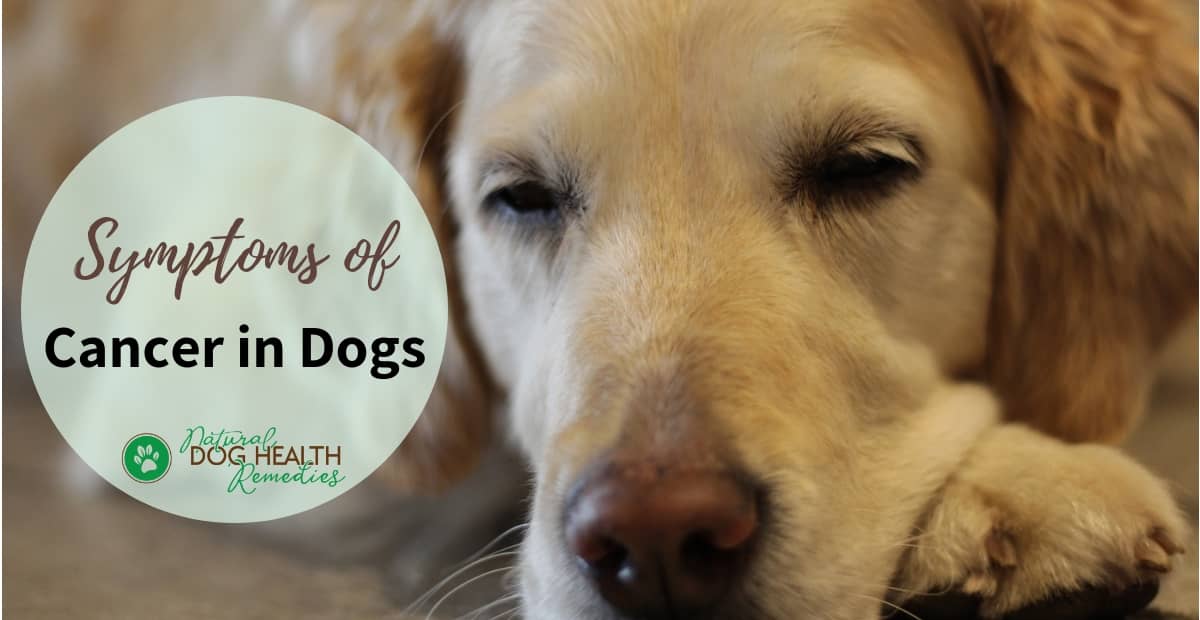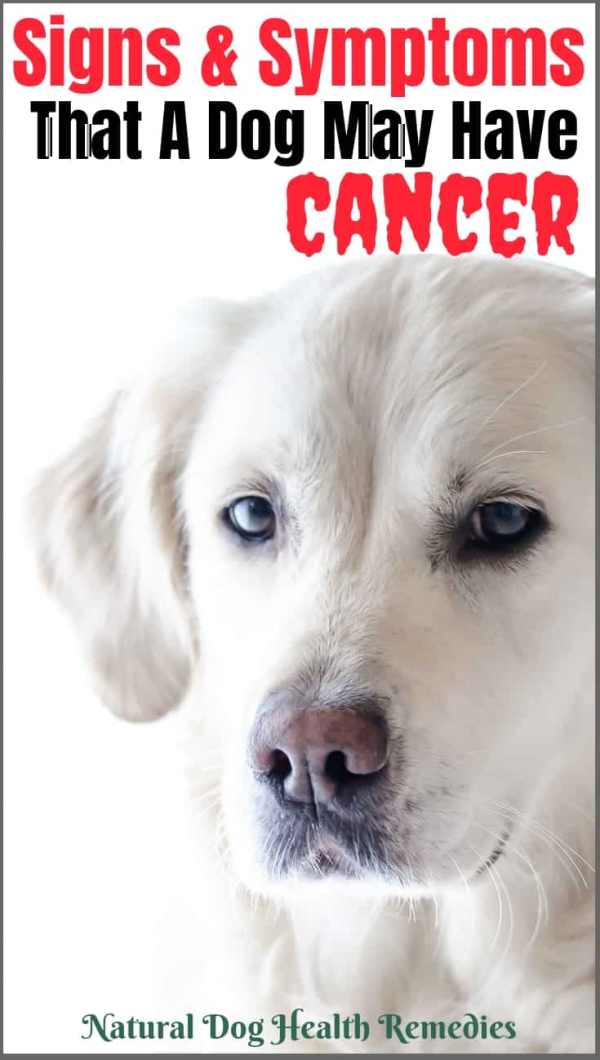Top Ten Symptoms of Dog Cancer

As cancer is getting more and more prevalent in our canine friends, we need to be as vigilant as we can in observing our dogs and trying to detect any abnormalities that may have arisen.
Some early signs and symptoms of dog cancer are non-specific and rather indistinct. It is difficult to tell whether a dog showing some cancer-like symptoms is in fact suffering from canine cancer or some other illnesses.
It is therefore helpful to get ourselves familiar with some common cancer symptoms in dogs, and at the same time, learn about some other more common disorders that may cause similar signs.
And when in doubt, go to the vet to hopefully get a proper diagnosis.
Top 10 Early Cancer Symptoms in Dogs
How to tell if your dog has cancer?
The following signs and symptoms are often shown by dogs suffering from cancer. (But note that they may be caused by some other forms of illnesses as well.)
Lumps and Bumps
Chronic skin problems, such as growths, lumps and bumps, itch and lesions, and wounds that do not heal, can be indicative of canine skin cancer.
Different forms of cancer (e.g. lymphomas, mast cell tumors, fibrosarcomas) can arise as lumps and bumps on a dog's skin.
Of course, not all bumps and lumps are cancerous.
Very often, benign growths such as warts and fatty tumors can arise in a dog's skin as well.
How To Tell If a Lump is Benign or Malignant?
Usually, any lumps and bumps that appear, then decrease in size or even disappear, and finally reappear in a larger size are more likely to be cancer than benign lumps.
But the only way to tell for sure whether a lump is cancerous or not is by a quick and painless process called fine needle aspiration, in which a needle is used to extract some cells from the lumps for examination under the microscope.
Chronic Coughing or Sneezing
Chronic respiratory issues, such as coughing and sneezing, can be a sign of cancer in dogs.
A dog having a chronic, non-phlegmy cough may have lung cancer. Sometimes the dog may cough up blood.
Sneezing, especially if accompanied by a bloody nasal discharge from only one side of the nasal cavity, may indicate dog nose cancer.
If your dog has a cough that doesn't seem to go away, or keeps sneezing with bloody discharge, be sure to take the dog to the vet for a checkup. The thing is, besides cancer, there are also other dog illnesses that cause the same symptoms.
For example, chronic coughing may be caused by heartworm infection, fungal infection of the lung, or heart disease.
Sneezing can be the result of allergies. Also, foreign bodies (e.g. foxtail) trapped up the dog's nasal cavity can cause sneezing and bloody nasal discharge.
Vomiting and Diarrhea
 Chronic gastrointestinal problems such as vomiting and diarrhea can be symptoms of cancer of the GI tract, or cancer anywhere else.
Chronic gastrointestinal problems such as vomiting and diarrhea can be symptoms of cancer of the GI tract, or cancer anywhere else.
But again, there are several dog illnesses (e.g. IBD, gastritis) that can cause the same symptoms.
It is important to have an early diagnosis of whatever disease the dog is suffering, since chronic inflammation of the GI tract may eventually progress to cancer.
Appetite & Weight Loss
Understandably, a dog with cancer usually loses his appetite, resulting in weight loss.
The problem is, appetite loss is one of those dog cancer symptoms that is indistinct, as many other diseases (e.g. dental or gum diseases, IBD, heart disease, to name just a few) can cause appetite loss in dogs as well.
Also, older dogs tend to eat less.
If you notice that your dog is suddenly losing his appetite, try to look for and convey any other accompanying symptoms to your vet so that a proper diagnosis can be made at the earliest possible time.
Blood in Urine or Urinary Incontinence
Dogs with prostate cancer or cancer in the urinary tract (such as bladder cancer) usually show these symptoms.
But urinary problems can also be caused by other problems, such as urinary tract infections, bladder stones, kidney disease, etc.
Signs of Pain
A dog with cancer no doubt has pain, and we need to learn how to recognize signs of pain in dogs (e.g. ears pinned backward, tail between legs, limping, drooling, crying out when touched, etc.).
Since many other diseases can also cause pain (e.g. arthritis, ear infections, dental or gum diseases, etc.), we should note other accompanying symptoms and tell the vet so that a proper diagnosis can be made.
Lameness
Bone cancer can cause a dog to limp.
If your dog starts limping, check for any swellings on the affected limb. A firm swelling (together with limping) very likely points to bone cancer.
Other canine illnesses that can cause lameness include arthritis, hip dysplasia, or some form of injuries. Dogs suffering from hypothyroidism may also have severe joint pain causing them to limp.
Lethargy and Weakness
Perhaps this is one of the most vague symptoms of all diseases!
Dogs with cancer do, understandably, become lethargic and weak. But a dog can be lethargic due to a zillion other reasons, e.g. pain from arthritis, anemia, fever caused by infections, and so on.
It is therefore important to look for and tell your vet any other accompanying symptoms that you may find.
Bad Breath
Oral cancer in dogs can cause bad breath.
If your dog's breath has recently become foul-smelling, be sure to take a close look inside his mouth. Watch out for any abnormal bleeding and growths. Also observe your dog to see if he seems to have pain in the mouth. Signs of pain include drooling, or even refusing to eat.
Of course, not all causes of bad breath are cancer. Perhaps more frequently, bad breath is caused by indigestion, dental/gum diseases, liver disease, and kidney disease.
Seizures
Brain tumors can cause seizures. If you have a dog (especially older dog) who has never had seizure episodes before, but has started having seizures, he may have a brain tumor. Usually, the dog will also show other symptoms, such as disorientation, staggering, hearing loss or loss of eyesight, head shaking.
Some other canine illnesses that can cause seizures include thyroid problems, kidney disease, liver disease, hypoglycemia, and poisoning.

The Bottom Line
As you can see, a lot of the above symptoms are not unique to cancer. That is exactly why very often cancer is not diagnosed until it is at a later stage.
The bottom line is, whenever a dog has a disorder that does not respond well to treatment in one to two months, and is showing some dog cancer symptoms, then the possibility of cancer should be considered and a more thorough examination should be requested.
Reject the suggestion of adopting a "wait-and-see" attitude. Timely action can save your dog's life!
 References
References
Eldredge, et al. Dog Owner's Home Veterinary Handbook 4th edition (Wiley Publishing, 2007).
Merck Publishing and Merial. The Merck/Merial Manual for Pet Health (Merck, 2007).
S. Messonnier, The Natural Vet's Guide to Preventing and Treating Cancer in Dogs (New World Library, 2006).





